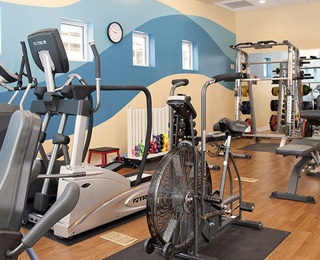Published: October 6, 2016
 All you need is a sturdy chair and pair of athletic shoes, maybe some hand or ankle weights, and you can ease arthritis pain, improve sleep, reduce falls and more.
All you need is a sturdy chair and pair of athletic shoes, maybe some hand or ankle weights, and you can ease arthritis pain, improve sleep, reduce falls and more.
Sure, you also need motivation, but after learning all the health benefits of strength, training you just might be moved to get moving, especially if you are an older adult.
Tufts University and the Centers for Disease Control and Prevention teamed up to develop a strength training program for older adults. “Growing Strong” is an exercise program based on research and includes many free resources, including animated exercises and a downloadable booklet.
First, the Health Benefits
Let’s start with arthritis relief.
“Tufts University recently completed a strength-training program with older men and women with moderate to severe knee osteoarthritis. The results of this sixteen-week program showed that strength training decreased pain by 43%, increased muscle strength and general physical performance, improved the clinical signs and symptoms of the disease, and decreased disability. The effectiveness of strength training to ease the pain of osteoarthritis was just as potent, if not more potent, as medications. Similar effects of strength training have been seen in patients with rheumatoid arthritis.”
Tufts also found seven more benefits:
- Improved balance, which leads to fewer falls;
- Bone strengthening, which leads to fewer fractures;
- Increased metabolic rate, which leads to proper weight maintenance;
- Better glucose control, which leads to fewer adverse effects of diabetes;
- Improved self-confidence and self-esteem, which leads to less depression;
- Improved sleep, which leads to overall better health and well-being;
- A leaner body, which leads to lower risk of heart disease.
The American Heart Disease now recommends strength training to reduce the risk of heart disease and as a therapy for patients in cardiac rehabilitation programs.
The Mayo Clinic also found that regular strength training could also improve thinking and learning skills for older adults.
Got Motivation?
Whether you have any of the health concerns and ailments list above, or just want to keep them at bay, the benefits of strength training are pretty convincing. Maybe you aren’t ready to commit to a lifelong training program, but are willing to give it a try.
Before pulling out that sturdy chair, though, check with your doctor, especially if you have been inactive or have health concerns. (The folks at Tufts even thought of that – here’s a quiz to help determine if you should call your doctor.)
A few basics to consider as you begin your exercise program.
The Department of Health and Human Services recommends incorporating strength training exercises into a fitness routine at least two times a week, about 20 to 30 minutes. Three times a week is even better. But remember, muscles need time to recover, so make sure there is one full day of rest in between training.
To get started, warm your muscles up with a brisk walk, bike or other aerobic activity for 5 to 10 minutes.
You can join a gym and use machines for strength training, or easily set up space at home for training. You might want to purchase hand and/or ankle weights and resistance tubing, both available in sporting goods stores.
Some Exercises to Get Started
Tufts University recommends squats to get started:
- In front of a sturdy, armless chair, stand with feet slightly more than shoulder-width apart. Cross your arms over your chest and lean forward a little at the hips.
- Making sure that your knees NEVER come forward past your toes, lower yourself in a slow, controlled motion, to a count of four, until you reach a near-sitting position.
- Pause. Then, to a count of two, slowly rise back up to a standing position. Keep your knees over your ankles and your back straight.
- Repeat ten times for one set. Rest for one to two minutes. Then complete a second set of ten repetitions.
As you progress, try step ups (stairs required), overhead press (hand weights required) and knee extension (ankle weights required).
To cool down, do a series of stretches involving quadriceps, hamstring, chest, arms, neck, upper back and shoulder.
 In the past, Molly Kavanaugh frequently wrote about Kendal at Oberlin for the Cleveland Plain Dealer, where she was a reporter for 16 years. Now we are happy to have her writing for the Kendal at Oberlin Community.
In the past, Molly Kavanaugh frequently wrote about Kendal at Oberlin for the Cleveland Plain Dealer, where she was a reporter for 16 years. Now we are happy to have her writing for the Kendal at Oberlin Community.





